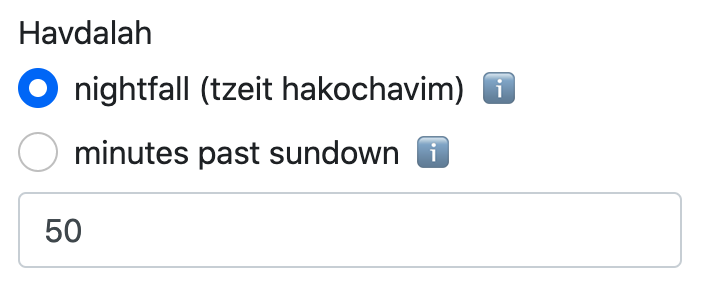Candle-lighting and Havdalah times are derived from sunset times, which are approximated from a location (latitude, longitude) and day of year. As of August 2020, Hebcal.com calculates zmanim (halachic times) using an algorithm published by the US National Oceanic and Atmospheric Administration. The NOAA solar calculator is based on equations from Astronomical Algorithms by Jean Meeus.
The sunrise and sunset results are theoretically accurate to within a minute for locations between +/- 72° latitude, and within 10 minutes outside of those latitudes. However, due to variations in atmospheric composition, temperature, pressure and conditions, observed values may vary from calculations.
Solar Calculation Details, NOAA
Differences of 1-2 minutes between Hebcal and other sources publishing candle lighting times or sunset times are expected. Remember that candle lighting times can only be approximated based on location.
Here are a few common reasons why you may see differences in candle lighting times:
1. Different minhag on when to light candles
By default, candle lighting time is 18 minutes before sundown (40 minutes for Jerusalem, 30 minutes for Haifa and Zikhron Ya’akov) on Erev Shabbat (Friday) and Erev Chag (Rosh Hashana, Yom Kippur, Sukkot, Shmini Atzeret, Simchat Torah, Pesach, Shavuot).
Other sources may use 20 minutes before sundown. Hebcal gives an option to specify a different number of minutes before sunset if you don’t follow the 18-minute minhag.
2. Different sunrise/sunset calculation engines
The sunset calculator we use on Hebcal.com as of August 2020 uses an algorithm published by the US National Oceanic and Atmospheric Administration. Hebcal’s NOAA algorithm is implemented in JavaScript using double-precision floating point arithmetic. Other sources may use a slightly different algorithm, for example from the United States Naval Observatory (USNO).
Even if the other source also uses the NOAA algorithm, the implementation could differ slightly; there are many constants and opportunities to round and truncate which could result in slight differences in the final calculated sunset time for a given day and location. For example, in December 2023, Hebcal switched to a different NOAA implementation that optionally supports elevation (more on this below). Even when the elevation feature is disabled, this alternate calculation engine resulted in small differences (often less than 10 seconds) versus Hebcal’s previous NOAA engine.
3. Different latitude/longitude definitions for a given city
Since 2013, Hebcal.com has been using lat/long definitions from GeoNames.org, which is available under a Creative Commons license. For the USA, we purchase a commercial ZIP code database from zip-codes.com that provides latitude and longitude for the “center” of each zipcode. For very large cities, the sunset at the east side of the city might be a minute earlier than the west side of the city.
4. Deliberate rounding down (or up)
Hebcal rounds candle lighting (Friday) times down to the nearest minute, and rounds Havdalah times up to the nearest minute. To be more precise, we use the floor minute for candle-lighting, and we use the standard mathematical rounding rule for Havdalah. The idea here is that it’s better to display candle-lighting time as much as 59 seconds earlier than strictly necessary, and for Havdalah it’s better to wait an additional 30 seconds to end Shabbat/yontiff.
For example, if the exact candle lighting time from the sunset engine (including seconds) was at 20:02:31 or even 20:02:59, Hebcal displays candle-lighting as 20:02.
On the other hand, if the Havdalah calculation is 21:17:29, Hebcal will display 21:17. If it were 21:17:30 through 21:17:59, Hebcal displays 21:18.
5. Havdalah minutes past sundown versus sun degrees below horizion
As of August 2020, options for Havdalah times have also changed. Hebcal now offers an option to use tzeit hakochavim, the point when 3 small stars are observable in the night sky with the naked eye (sun 8.5° below the horizon). This option is an excellent default for most places on the planet. We also offer the option to use a fixed number of minutes past sundown. Typically one would enter 42 min for three medium-sized stars, 50 min for three small stars, 72 min for Rabbeinu Tam, or 0 to suppress Havdalah times.

6. Elevation above sea level
As of December 2023, the Hebcal sunrise/sunset algorithm has been enhanced to optionally include the elevation of the location. If selected, Hebcal will include the city’s elevation in the calculation of all sunrise/sunset based zmanim. Elevation will affect the result only for calculations that are a fixed number of minutes before or after sunrise/sunset.
For cities at a high elevation (for example Denver Colorado or Mexico City), including elevation above sea level can change the estimated sunset time by as much as 7 minutes. If you want to learn more, our friends at KosherJava have a short article entitled How Much Earlier is Sunrise on Mount Everest Due to Elevation?
Degree-based zmanim (for example the “nightfall” option for Havdalah, or the start time of minor fasts at Alot haShachar) are driven by the amount of light in the sky and are therefore not impacted by elevation.
To enable the elevation option, select the “Include elevation in sunrise/sunset estimate” radio button as displayed in the screenshot below:

Conclusion
Lastly, remember that the NOAA algorithm can only approximate the candle-lighting times for your location. If you ever have any doubts about Hebcal’s times, consult your local halachic authority.